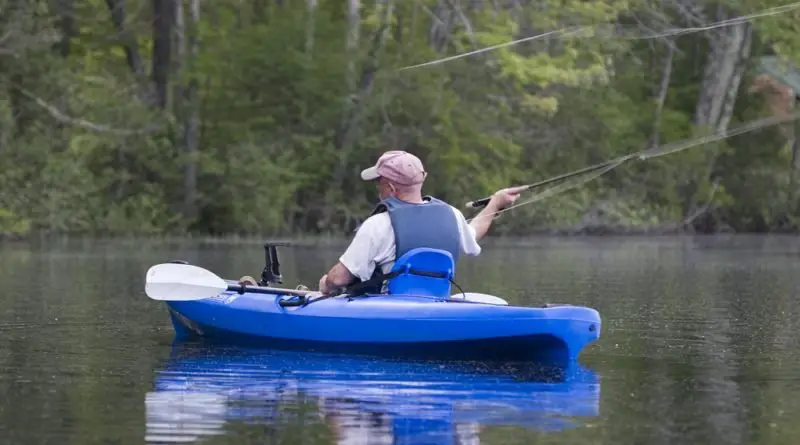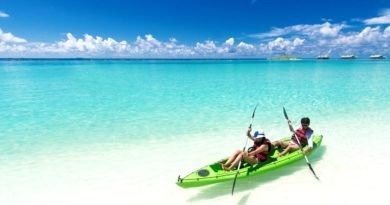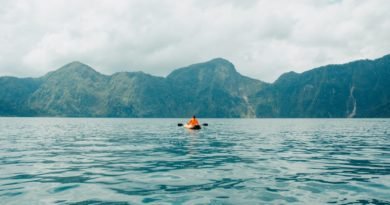Last modified on March 17th, 2022 at 2:16 pm
Fly Fishing From a Kayak: 9 Ways to Get Started
Fly fishing is different from typical fishing, where a person casts their line in the water and waits for the fish to bite. Fly fishing is a very active form of fishing. Typically, fly fishing will require a person to wade or stand in the middle of a running river or stream. A fly fisher must constantly cast their line to different areas of the river or stream to find that one perfect spot that the fish sees, then bites their fly line as it lands on top of the water. Fly fishing from a kayak can add to the fly fishing experience because the kayak will allow the angler to move around in the water to places that may have been unreachable from simply wading in the water.
Can You Fly Fish Out of a Kayak?
Fly fishing out of a kayak is entirely possible and can be a great way to experience fly fishing, rather than the traditional fly fishing method of wading into a stream or river. A kayak is easily navigated up and down rivers, can maneuver in and out of tight spaces, and is also easy to transport to and from the water. These benefits make fly fishing out of a kayak convenient and fun.
Below are the nine steps to take to get started fly fishing from a kayak.
1. Choose the Right Style Kayak For the Job
Generally speaking, there are two types of kayaks to choose from: the sit-in and the sit-on-top style kayak. In fact, there are kayaks specifically made for fishing. These fishing kayaks are almost always the sit-on-top design.
There is good reason for anglers to use the sit-on-top design kayak too. These kayaks provide more stability in the water, hold more weight for additional gear, and include more deck space to store fishing gear.
Plus, the sit-on-top will allow for standing up while casting. If you’re short on storage space for a hard-shell fishing kayak, there are even inflatable kayaks made specifically for fishing.
In exchange for these attributes, you’re going to give up speed and maneuverability in the water. The sit-in kayak is meant more for touring lakes, rivers, and large bodies of water using a combination of speed and agility to navigate river currents and rougher water.
Here are the main features you’ll want to look for in a good kayak for fishing:
- Sit-on-top design
- 10 feet to 14 feet in length
- Maximum weight capacity of 350-400 lbs.
- Flat or pontoon hull
Kayak fly fishing will place more emphasis on stability and weight capacity than speed and maneuverability. This way, a fly fisherman can focus on enjoying the outdoors and casting that perfect line into the water.
2. Rig You Kayak For Fly Fishing
With the correct kayak chosen, it’s time to customize the kayak to prepare for kayak fishing. Being outdoors on the water while fishing is undoubtedly a great way to spend the day, but you’re going to be sitting in the kayak for an extended period of time.
Choosing a kayak seat that is specifically made with fishing in mind is a must-have. There are seat options that offer more back support, a vented seat back for hot days, and very comfortable padding.
If you do happen to reel a fish in, having a foldable fishing net will be key to getting the fish from the water to the kayak. Even though a sit-on-top fishing kayak will offer stability, don’t test the stability by leaning over the edge of the kayak to try and pull a fish in.
Lastly, use a plastic crate stored in the back–or the stern–of the kayak. Keep extra gear in this crate so the front of the kayak is clear for sitting and standing as needed.
3. Stay Anchored in the Water
Kayak fly fishing will be done mostly in rivers and streams. Depending on the flow of the current, you’re going to have to constantly fight the current to keep the kayak in one spot for fishing.
If the river current is pushing the kayak downstream, it will be a challenge to fish in a certain area or avoid obstacles in the river.
Adding an anchor to a fishing kayak will solve this problem of the kayak being thrown off-course because of strong winds or currents.
4. Keep the Deck Clear of Obstructions
Casting a line when fly fishing is much different than casting a normal fishing pole. The line used is longer and heavier when being cast.
Because of the longer line being cast into the water, it’s pretty easy to get it caught on parts of the kayak. Keep all loose and unused gear stored behind the seat if possible. This way, there aren’t any obstructions for the line to get caught on at the front or sides of the kayak.
It’s also a good idea to lay down a small tarp at the front, or bow, of the kayak. This is so the fly fishing line can lay on the tarp and not get caught on any of the gear that’s stored.
5. Alter Casting Technique When Kayak Fly Fishing
Because a kayak sits near the water line, it makes it more difficult to cast out into the water from the kayak in a seated position.
When back casting from a kayak, you’ll need to alter the cast so the line doesn’t hit the water behind you. Keep the back cast high so the tip of the line doesn’t hit the water behind the kayak.
It will help to be at a higher position in the kayak when casting. If you’ve brought a cooler along to store food or drinks, it’s possible to sit on the cooler for a higher casting position.
Another option is to kneel in the kayak, right in front of the seat. Although, it’s smart to wear knee pads or put down some padding in the kayak.
As a last option, standing in the kayak while casting is the best way to cast, but offers the least amount of stability.
6. Choose Calm Water to Begin With
If kayak fly fishing is a totally new endeavor, it will be a smart move to not take on too much at once. Choose a calm lake or an easy-going river to start with. If you’re around the west coast of USA, fishing is only one of many fun things to do in Lake Tahoe.
No longer being shackled to the river bank or shoreline is a great feeling. Paddling a kayak with all the fishing gear at your disposal, along with the freedom to explore the surroundings can make fly fishing even better.
However, a newer kayaker should learn the ropes of kayaking an area. Don’t choose the fastest flowing river, or go out on a day when the weather is threatening.
7. Consider Adding a Fish Finder
Paddling a kayak up and down a stream or river while enjoying the scenery is a great way to spend an afternoon. Adding some fly fishing to that is even better. However, sometimes a considerable amount of time can be spent figuring out where to position the kayak and drop the anchor. A fish finder can help solve this issue. A high-grade fisher and depth finder can narrow down the area where you’re kayaking that will find the most fish.
8. Use Rod Holders Designed For a Fly-Rod
Most rod holders are designed to house a traditional fishing pole. The normal fishing pole has a longer handle behind the reel. The rod holder is basically a plastic tube to stick the rod handle in.
A fly-rod is the opposite design. The handle behind the reel is very small. The fly-rod is meant to be held above the reel. Make sure to buy and install a fly-rod-specific rod holder for your kayak. It’s even possible to use some PVC to make one of your own
9. Learn Basic Kayaking Skills
Don’t take for granted learning some basic kayaking skills before hitting the water and ready to fly fish.
Will you know what to do if the kayak tips over and capsizes? Will you know how to get back in the kayak if you end up in the water? Even basic paddling technique is good to know and practice before going full speed in the water for a day of fly fishing.
Final Thoughts | Fly Fishing From a Kayak
Fly fishing from a kayak can be a whole new way to explore a river and better enjoy the outdoors. Fishing from a kayak will also expand the range of fishing, rather than standing at the bank of the river.
First, learning some basic tips and skills related to kayaking and fly fishing from a kayak will have you out on the water in no time.

Marty Kelly is the founder and editor at activelyoutdoor.com. We write informational content about various outdoor hobbies and activities such as kayaking, canoeing, camping, hiking, fishing, and more. We specialize in helping beginners discover actionable tips and information regarding staying active and enjoying the outdoors.
Website: https://activelyoutdoor.com/




